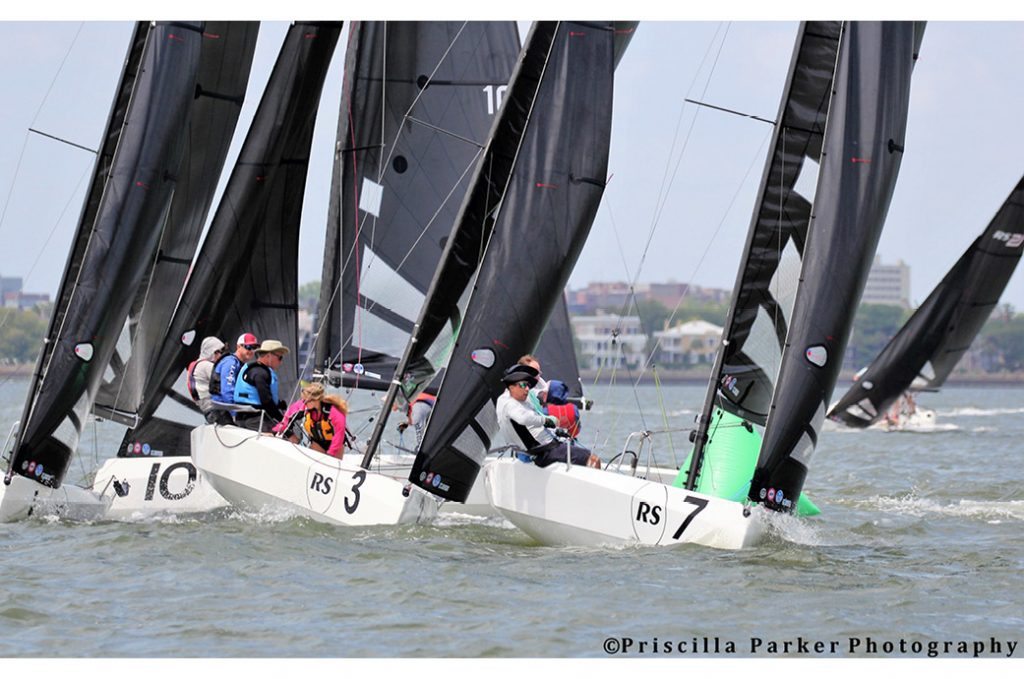The layline is a critical part of any windward leg because every boat has to get there eventually and, once they do, it’s a tactical dead-end. The closer you come to a layline, the fewer options you have, so you need smart tactics whenever you are approaching (or avoiding) it.
When you’re behind
Going to the layline when there are boats ahead of you is like running into a dead-end alley while you are being chased: there is no escape. So when you’re behind, a basic tactical rule of thumb is to stay away from the laylines.
Of course, you can’t avoid the layline forever. But the farther you are from the mark when you reach the layline, the more risk you take (of other boats tacking on you). So consider tacking short of the layline to keep options open.
As you get closer to the mark, it’s OK to go to the layline, especially when there aren’t so many boats around you. But if you think other boats may tack on you, go a little past the layline before tacking. This will encourage them to tack in front of or to leeward of you (where they won’t hurt you so much), and it will give you room to foot slightly if they do tack on your wind.
When you’re ahead
When you’re concerned about the boats behind you, the layline is your friend because once you are there it’s very difficult for other boats to pass you. Therefore, another good tactical rule of thumb is to push the boats you are beating toward a layline.
If possible, ‘herd’ the boats behind you toward the layline on the unfavored side of the course (so you will gain strategically as well as tactically) and/or toward whichever layline is closer (so they reach the dead-end as soon as possible). The further you are from the mark, the more effective this tactic becomes.

It’s usually not a great idea to get to the layline first because boats that are ahead of you will then be able to tack on your wind. © Priscilla Parker
The port layline temptation
When you must round the windward mark to port, there is often a traffic jam on the starboard-tack layline but hardly anyone on the port-tack layline. That’s because it can be difficult to tack near the mark without breaking a rule. However, many of the boats on starboard tack have to sail in bad air or overstand the mark. That’s why it’s often tempting to approach on port.
When you do this, however, you must be careful tactically. If you come right in to the mark on the port-tack layline you will be asking for trouble, especially if you’re in the middle of a pack.
It’s almost always better to be at least several lengths to leeward of the port-tack layline. You want to be far enough away so that, when you reach the starboard layline and tack for the mark, you have room to complete your tack (i.e. get to a closehauled course on starboard tack) before you enter the two- length zone around the mark. This will make it much easier to avoid breaking any rules.
Two tacks or sail in bad air?
If you’re on the layline and a boat tacks on your wind, should you tack twice to get clear air, or just continue sailing to the mark in bad air? Your best tactical option depends on at least two factors:
1) How far you are from the mark. Obviously if you are only a few lengths from the mark it would be better to keep going, but if you are half a mile away it’s probably better to make two tacks. The tradeoff point is some place in between where the cost of two tacks is equal to the cost of staying in bad air; and
2) How much you are being hurt by bad air. If it’s windy and you can sail almost as fast in dirty air, then you should probably keep going. But if you’re sailing in light air (where wind shadows can really hurt), then you should definitely consider two tacks (especially if there is any chance the bad air means you won’t fetch the mark). ■
This article originally appeared in David Dellenbaugh’s Speed & Smarts, The newsletter of how-to tips for racing sailors. If you want to sail faster and smarter, log onto SpeedandSmarts.com.




